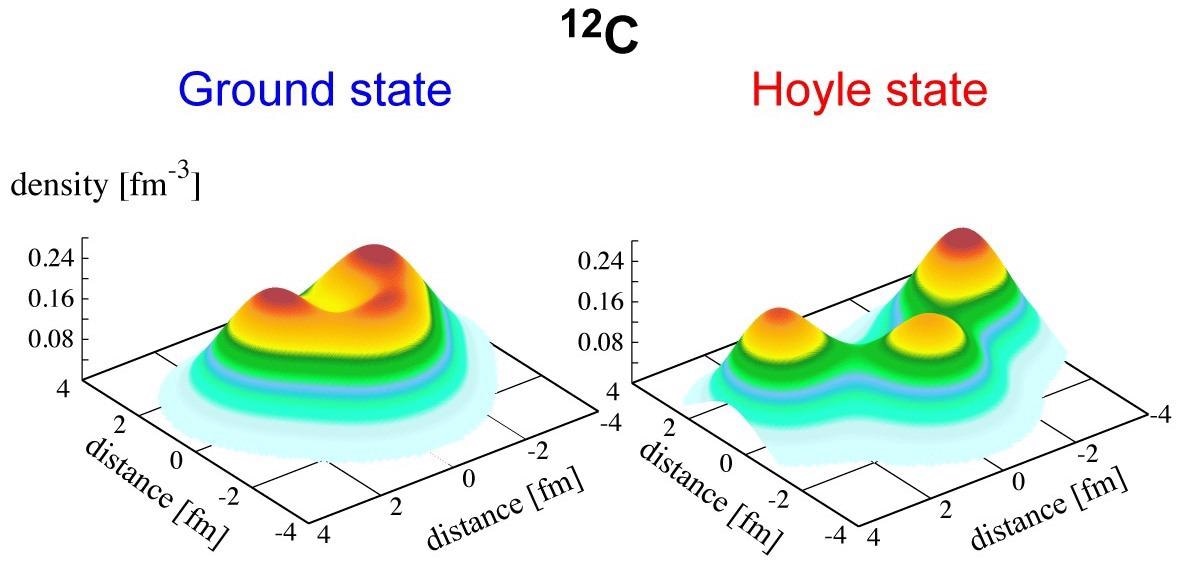An international research group has theorized how the extreme conditions in stars tend to produce carbon-12. This was done with the help of the world’s strongest supercomputer and new artificial intelligence methods. They explain this phenomenon as “a critical gateway to the birth of life.”
 These computer simulations show the structures of carbon-12 in the unstable, excited Hoyle state and as a stable ground state, the stuff of life. Image Credit of James Vary.
These computer simulations show the structures of carbon-12 in the unstable, excited Hoyle state and as a stable ground state, the stuff of life. Image Credit of James Vary.
The basic question of the research was: “How do the cosmos produce carbon-12?”, stated James Vary, a professor of physics and astronomy at Iowa State University and a longtime member of the research collaboration.
It turns out it’s not easy to produce carbon-12.
James Vary, Professor, Physics and Astronomy, Iowa State University
It takes the extreme pressure and heat within stars or in stellar collisions and explosions to make rising, unstable, and excited-state carbon nuclei with three loosely connected clumps, each with two neutrons and two protons.
A fraction of such volatile carbon nuclei could shoot off a little additional energy in the form of gamma rays and transform into stable carbon-12, the stuff of life.
The study published in the journal Nature Communications explains the researchers’ supercomputer simulations and consequent theory for the nuclear structure of carbon that aids its development in the cosmos.
The study’s corresponding author is Takaharu Otsuka of the University of Tokyo, the RIKEN Nishina Center for Accelerator-Based Science, and the Advanced Science Research Center of the Japan Atomic Energy Agency.
The study explains how alpha particles — helium-4 atoms, with two neutrons and two protons — could develop a cluster to form much bulkier atoms, such as an unstable and exciting carbon-12 state known as the Hoyle state (forecasted by theoretical astrophysicist Fred Hoyle in 1953 as a precursor to life as one know it).
The scientists write that this alpha-particle clustering “is a very beautiful and fascinating idea and is indeed plausible because the (alpha) particle is particularly stable with a large binding energy.”
For this theory to be tested, the scientists ran supercomputer simulations, such as calculations on the Fugaku supercomputer at the RIKEN Center for Computational Science in Kobe, Japan. Fugaku is listed as the strongest supercomputer in the world and is three times more powerful compared to No. 2. This is as per the latest TOP500 supercomputer rankings.
Vary stated that the scientists also did their work ab initio, or from first principles. This implies that their calculations were dependent on known science and did not include extra parameters or assumptions.
Also, more techniques were developed by the researchers in statistical learning, known as a branch of computational artificial intelligence, to disclose alpha clustering of the Hoyle state and the ultimate production of stable carbon-12.
Vary stated the team has worked for more than 10 years to develop its software, improve its supercomputer codes, run its calculations and figure out smaller issues while building up to the present work.
There’s a lot of subtlety—a lot of beautiful interactions going on in there.
James Vary, Professor, Physics and Astronomy, Iowa State University
The researchers said that all the calculations performed, physical quantities and theoretical subtlety correspond to what experimental data there is in this corner of nuclear physics.
So, they think they have some fundamental answers regarding the origins of carbon-12. Vary said that should result in more studies searching for “fine-grain detail” regarding the process and how it functions.
Was carbon production, for instance, majorly the outcome of internal processes in stars? Vary asked. Or was it supernova star explosions? Or collisions of super-dense neutron stars?
One thing is now clear to the researchers.
This nucleosynthesis in extreme environments produces a lot of stuff including carbon.
James Vary, Professor, Physics and Astronomy, Iowa State University
Journal Reference:
Shibuta, M., et al. (2022) Al13− and B@Al12− superatoms on a molecularly decorated substrate. Nature Communications. doi.org/10.1038/s41467-022-29034-9.